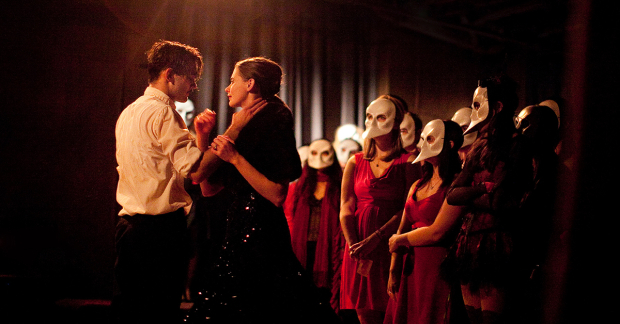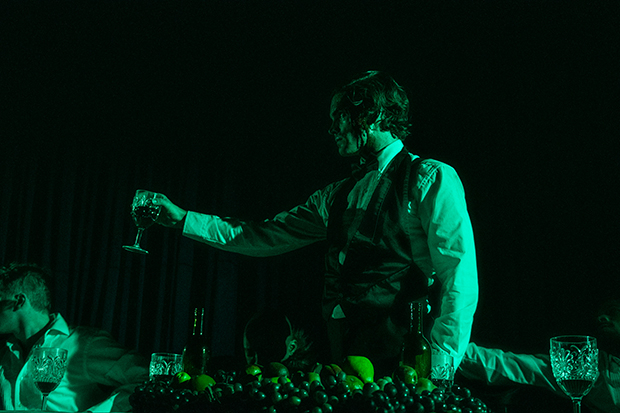Sleep No More Is Open, and Opening Eyes in New Ways After Two Years of Covid
We talked with creatives behind the long-running immersive show who have found fresh meaning in its unique storytelling.

(© Robin Roemer)
When Sleep No More premiered in New York in 2011, it was planned for a six-week run. The sweeping avant-garde production, an immersion of Shakespeare, film noir, and dance, introduced a uniquely new experience to adventurous theatergoers. Ten years later, following multiple extensions and a pandemic and an industry shutdown, it still is.
A fever dream of Shakespeare's Macbeth à la Alfred Hitchcock, Sleep No More could be described as a shadowy, cinematic "choose your own adventure." Participants are invited to enter the McKittrick Hotel, a vast warehouse space transformed into the production's eerie environment by Punchdrunk, the British theater company known for its site-specific, immersive productions.
Moving through suggestively dark rooms and hallways, people can explore independently or follow a cast member for minutes or hours at a time. One turn of a corner could lead into a bedchamber where a sensual dance of passion and violence is taking place, while another turn might lead to a hedonistic rave, complete with pulsing music, flashing lights, and flowing blood.
Sleep No More first opened its doors in London, followed by a run at Massachusetts's American Repertory Theater, but moving to New York was a risk, due to the size of both the cast and the set. Carrie Boyd, director of performance and production, described it as a "roll of the dice" and was surprised by the show's fast and passionate reception.
"I had sort of seen it in microcosm how I could take off in a community," Boyd, who had worked on the ART production, said. "But New York is such a such a gamble. It was wonderfully surprising when it when it had that same sort of reception."
As the co-artistic director of NU Dance, Sophie Bortolussi already had experience with site-specific, immersive productions when her partner called her in tears, saying, "They're doing our dream." She had seen Sleep No More at the ART, and Bortolussi quickly followed suit. After being "blown away" by the experience, she auditioned for the New York opening and was cast as Lady Macbeth.
When the McKittrick shut its doors in 2020 during the first wave of the COVID-19 pandemic, Sleep No More's creators seized the opportunity to revisit the show. Sharing lists and spreadsheets, Boyd and her colleagues began the process of updating the production. Small changes were made to choreography, lighting, and even its signature mask. The ghostly white plastic headpiece now accommodates an N-95 mask all participants are required to wear.
"Having such a rare opportunity to go back and think about exactly how you do things differently, and then actually be able to achieve that and do it was sort of the cherry on top for the whole experience for some of us," Boyd said. "When we opened back up in February, it really felt like the very beginning again when we first opened, because everything was truly as it was originally intended."
Changes to the creative team were made as well. Bortolussi returned to Sleep No More, this time as both resident director and actor. Her new title has required her to examine and absorb the entire production, as well as the its physical space.
"It's what I keep saying to the performers – the space says so much already," she said. "You have to stay so much in tune to where you're at, and it's such an incredible balance between light and sound and the space itself."

(© Yaniv Schulman)
It was because of that space that Bortolussi drew upon her independence while creating the role of Lady Macbeth. The sheer size of the the venue and cast required her to guide herself at times.
"When you create the show, you kind of have to be your own director a little bit," she said. "You have very clear direction, but then you spend a lot of time alone. I felt like I've already had a really great sense from being part of the initial cast, but then of course, I was not knowing in detail every single character of the show, which now I know."
In the years following Sleep No More's opening, immersive theater's popularity has surged, with participatory experiences opening throughout the boroughs. Boyd credited the appeal to partly people's enjoyment of feeling in control and partly to the necessity of turning off their phones and engaging with the environment.
"I think so many of us will be scrolling through our phone while watching TV or doing something else. I think like the way that [Sleep No More] is crafted really forces you to let go through everything else and be so present," she said. "Particularly in this day and age, we don't get the opportunity or we don't force ourselves into that that sort of opportunity very often. So I think when it does happen, it feels so much more remarkable, because we really are zoned in on our senses, and something like Sleep No More is such a sensory overload. I think it's impossible to not get fully pulled into the experience and sort of forget yourself in a really lovely way that I personally don't get to experience in any other capacity in my day to day."
That appeal has lasted; returning to Sleep No More, Bortolussi was struck by its timelessness. The themes of power, corruption, violence, and guilt that imbue Macbeth speak powerfully to a post-2020 audience.
"Coming back to the show after being away from it for few years has been quite amazing," she said. "Some scenes still blow my mind, the intricacy of the scenes, of the whole show in just incredible… The web of connections that is developed throughout the building, throughout the evening is just phenomenal. Even 10 years later it doesn't feel that the show has aged."
That permanence, Boyd said, also comes from Shakespeare's script. Audience members who have not read the play since high school are still struck by iconic moments from the story.
"I don't know what it is about the timelessness of the of the piece," she said. "I think Lady Macbeth's concept is also something that tends to stay with people for a very long time. Her bath scene – that is just such an iconic image. It's obviously very removed from the source material, but it's such a touch point for so many people. It's incredible."
They are far from alone in this opinion. Sleep No More has inspired a passionate group of fans, some of whom have seen it more than 70 or 80 times. Returning to the McKittrick, they even picked up on the slight changes in the show. Their excitement at seeing new content, while recognizing cast members from the past who have returned, was noticeable, Boyd said.
Sleep No More tells a story of tragedy – greed, heartbreak, and death – which many people experienced intimately during the past two years. It's no surprise their experience of the show has changed as well, Boyd said.
"I think we all came back to the work slightly evolved after the shutdown and those years of reassessments and contemplation. It's very interesting seeing people coming back into roles that we've seen them in before big life changes – people have started families or new careers during the break. I think everyone's coming back with a lot of a lot of new depth to see familiar faces and roles."

(© Umi Akiyoshi)








